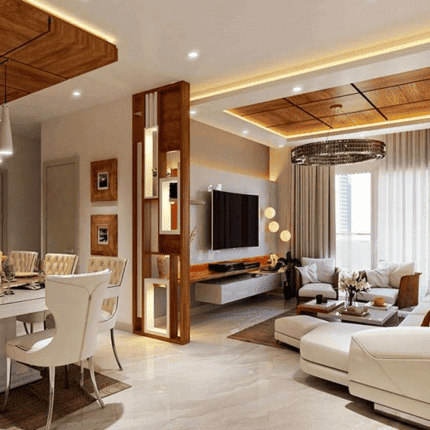As home aesthetics continue to evolve in India, one element gaining strong visual importance is the television wall. Far from being just a spot to mount a screen, it now plays a leading role in how modern interiors are composed. Behind this shift is the increasing influence of the modular LED TV panels designer, whose work combines layout precision, style integration, and technological adaptability. These professionals are redefining what it means to have a smart, sophisticated living room centerpiece.

The latest design thinking shows that LED TV panels are no longer standalone fixtures but part of a unified modular interior plan. From materials to layout, each trend reflects how homes today demand personalization, efficiency, and multi-functionality—all without compromising on design integrity.
Integrated Panels That Anchor the Living Space
The modular LED TV panel is now an essential design anchor. Instead of appearing as a bulky afterthought, the television panel is incorporated into the overall room flow. Designers focus on alignment with shelving, cabinetry, and lighting to ensure everything appears intentional.
This integrated approach is especially visible in properties designed by top professionals in cities like Lucknow. A leading modular LED TV panels designer integrates soft-close units, flush finishes, and storage framing around the screen to create visual harmony and usability.
Surface Finishes That Reflect Personal Style
Homeowners now seek surfaces that match their personality or broader home themes. While laminates and plain wood finishes still find use, fluted textures, matte blacks, marble-look acrylics, and even leather-clad surfaces are increasingly popular. The idea is to give the TV area a bespoke finish that complements the entire home palette.
This trend is in line with the growing demand for consistency across modular elements, particularly in high-function areas. As seen in projects involving modular kitchen design in Lucknow, clients often request matching tones and finishes across the kitchen and living room zones, creating a seamless interior narrative.
Dynamic Layouts for Flexible Viewing
The rise of flexible living spaces has prompted designers to think beyond static wall mounts. Depending on room layout and usage patterns, designers now plan for rotating mounts, recessed TVs, or hidden screens that slide into place. In open living areas, where visibility matters from multiple angles, this flexibility enhances comfort and usability.
In high-end modular homes, designers are ensuring that layouts support future adjustments. These configurations are aligned with the kind of forward-thinking found in the Best Modular Interior Home Design in Lucknow, where furniture, paneling, and structure all adapt to lifestyle changes over time.
Blending Entertainment with Storage
Today’s modular TV panel is often designed as a multifunctional wall. In many cases, the panel is surrounded by cabinetry, shelving, and sometimes even fold-out desks or bar units. This design direction reflects the space-conscious mindset of today’s homeowners, especially in compact apartments.
Leading designers often collaborate across wardrobe and entertainment zones to ensure consistency in form and material. That’s why features like concealed drawers, handleless doors, and sleek vertical storage also appear in Custom Modular Wardrobe Price Lucknow layouts. The result is a living space that looks coordinated and operates efficiently.
Lighting as a Built-In Element
Lighting within modular panels is now essential, not decorative. Designers are integrating soft LED strip lights along panel edges, under shelves, and behind screens. These layers of ambient lighting help soften screen glare, create mood, and highlight material depth.
This feature is particularly appreciated in homes that prioritize a layered lighting approach. A skilled modular LED TV panels designer understands how light placement can elevate not just visibility but the overall spatial experience of the room. Subtle wall washers or backlit textures make the panel a visual statement even when the TV is off.
Minimalism for Urban Living
Modern TV panels are adopting minimalist configurations. Floating units, slim borders, and wall-to-wall designs with zero visual clutter are in high demand. Especially in metro cities, minimal panels help rooms appear more spacious while maintaining their function.
This clean look also resonates with broader interior styling trends seen across Lucknow and other urban hubs. The approach mirrors what the best interior designers in Lucknow are currently implementing—designs that breathe and blend without overwhelming the space.
Modular Scalability for Long-Term Use
Adaptability is no longer optional. Modular panels today are built to support changes in screen sizes, audio upgrades, and even integration with AI-based home systems. Designers use adjustable shelving, universal brackets, and compartmentalized back panels to accommodate future modifications.
These scalable ideas reflect what many clients now expect from their interiors—long-term adaptability without complete overhauls. Similar to what’s seen in Custom Modular Kitchen Price Lucknow solutions, people want layouts that grow with them, not limit them.
Theme-Based TV Panel Styling
Beyond structure, aesthetics are increasingly guided by home-wide themes. Designers now craft TV units that follow a clear visual storyline: whether it’s Scandinavian, Japandi, contemporary luxe, or heritage modern. Matching ceiling lines, floor finishes, and panel colors have become part of an intentional look.
These thematic elements often extend into the kitchen, dining, and work zones. Homes that opt for the Best Modular Interior Home Design in Lucknow often show consistency in detailing—using tone, texture, and placement across spaces for cohesive storytelling.
Conclusion: TV Panels as the Modern Design Frontier
As the boundary between technology and interior aesthetics continues to fade, the TV panel has become more than just a screen holder. It’s now a dynamic part of the room’s visual and functional ecosystem. What defines a quality modular LED TV panels designer today is not just skill in carpentry or finishing, but the ability to predict user needs, translate them into scalable layouts, and deliver a product that feels both personal and timeless.
The future of home design lies in its ability to evolve. From wardrobes to kitchens to entertainment walls, modular thinking ensures that every element of the home is optimized not just for today, but for years to come.







